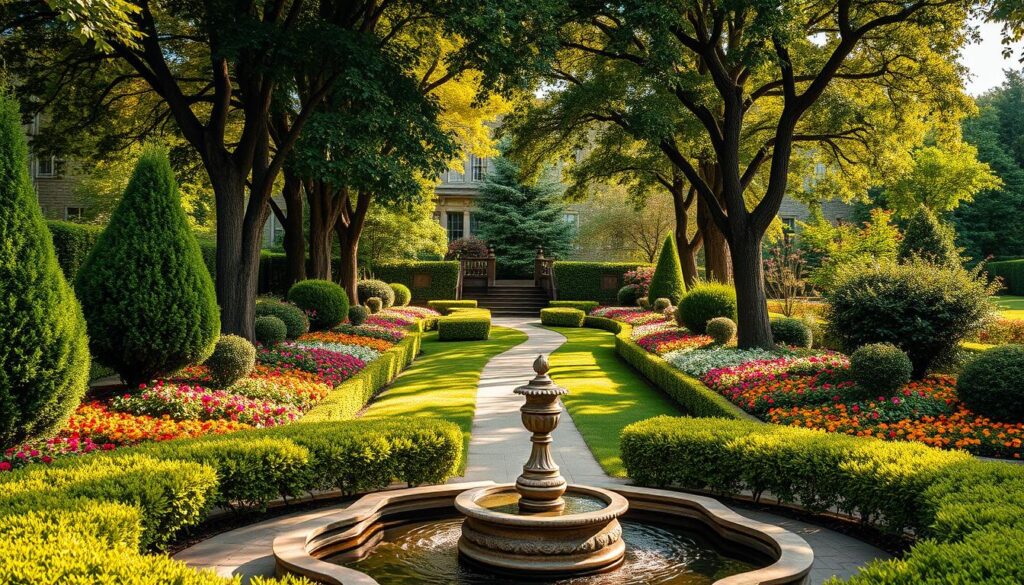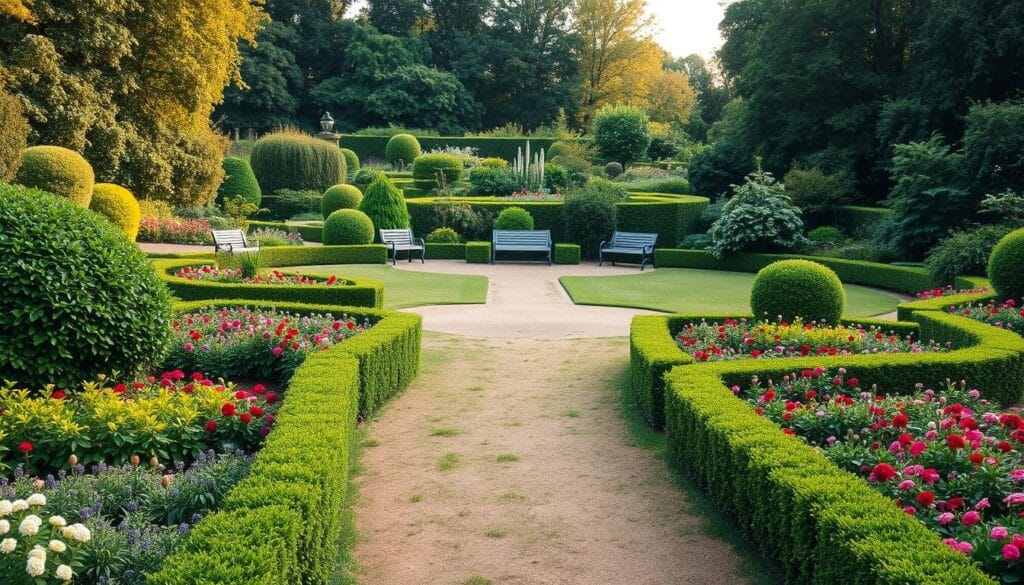Transform Your Space with Garden Design

About the Game
Good garden design makes your outdoor space a beautiful retreat. By planning and using creative landscaping ideas, you can change your yard’s look and feel. Whether you want a complete makeover or just to enhance certain parts, smart design turns dull spots into welcoming places. Let’s dive into what makes an outdoor space both pretty and useful.
Creating a Functional Layout
A good layout is key for any garden. It makes it look nice and useful too. Think about how people will walk around. Make sure paths are clear and welcoming.
Use materials like gravel, stepping stones, or wood for paths. This helps everyone move easily. Plus, it looks great.
Anúncios
Understanding Traffic Flow in Your Yard
First, look at main entry points and key spots in your garden. A natural flow lets everyone get around easily. This makes visiting your garden more fun.
You can make things clearer by:
Anúncios
- Creating wide paths for busy areas
- Utilizing curves to draw the eye and guide movement
- Incorporating signage for smaller spaces
Maximizing Functionality in Small Spaces
In a small yard, being organized is a must. Pick what’s important for your garden. Functional gardening means making the most of little spaces.
Here are some smart ways to do it:
- Designating zones with outdoor rugs or trellises
- Using raised beds to grow more without taking up too much space
- Choosing furniture that can be used for sitting and storing

Incorporating Structural Elements in Your Garden
Adding structural elements can make any garden look more beautiful and work better. They help define different areas and make your garden more interesting to look at. Fences and hedges are great for marking borders and keeping your space private. Choosing the right plants for your hedges, like evergreens or deciduous ones, will keep your garden green all year long.
Adding Fences and Hedges for Definition
Fences can be made from wood, vinyl, or metal, each offering its own unique look. This lets you make your garden match your personal style. Hedges can be tall or short and thick or thin, depending on what you need them for. Yew and hornbeam are good choices because they’re pretty and can make your garden feel like a private retreat.
Architectural Features like Arches and Gates
Adding things like arches and gates can make your garden truly special. Arches draw attention and encourage people to explore, especially when covered in bright flowers or plants that climb. Gates do more than let people in; they’re also a key part of your garden’s style. Each of these features helps to make sure your garden is welcoming and neatly arranged.
Embracing Vertical Gardening Techniques
Vertical gardening is a smart way to use little space, especially in cities. It allows for beautiful, space-efficient gardens that bring life to any area. Plus, it helps keep the garden healthy by improving air flow and reducing pests and diseases.
Benefits of Vertical Gardening for Small Spaces
Vertical gardening has many perks for small spaces:
- It uses upward space, so you can grow more plants without needing more ground.
- A green wall adds beauty and interest, making any urban spot livelier.
- It ensures better air movement around plants, decreasing the chance of diseases.
- Makes reaching for crops easier, which is helpful for gardeners of every age.
Popular Plants for Vertical Growth
Choosing the right plants is key for a thriving vertical garden. Here are top picks:
- Tomatoes – They work well on trellises and supports, offering tasty rewards.
- Cucumbers – Their vining nature makes them a fit for vertical gardens.
- Beans – These quick growers can fill up vertical spaces fast, perfect for compact gardens.
- Strawberries – They do well in vertical setups, saving valuable ground space.
- Flowering vines – Morning glories and sweet peas bring color and vibrancy to vertical gardens.
Designing Outdoor Rooms or Zones
Transforming your garden into outdoor living spaces boosts its look and function. Creating zones like dining areas, relaxation spots, or places for fun lets you enjoy outdoors more. These garden rooms link different areas smoothly, making them pretty and useful.
To design great outdoor zones, think about:
- Zoning: Use plant layouts to mark areas, making sure each has a specific role.
- Furniture Placement: Put tables, chairs, and loungers in spots that promote talking and are easy to move around.
- Built-in Seating: Add benches or layered seating that fits with your garden look, creating cozy spots for hanging out.
- Pathways: Make clear paths connecting each zone, improving access and guiding visitors.
With these ideas, your outdoor areas can serve many purposes. They make your time outside richer.
Utilizing Container Gardening for Limited Spaces
Container gardening is perfect for those with little space. It makes patios, balconies, and small yards burst with green life. You can get creative with plant arrangements and choose from a wide plant variety. Picking the right pots and knowing what your plants need are key.
Choosing the Right Containers and Plants
The containers you pick play a big role in your plants’ health and looks. Keep in mind:
- Material: Choose from clay, plastic, or metal pots. Each type has its own pros regarding weight, lasting quality, and look.
- Size: Match the pot size to the plant’s root space needed. Big plants need large containers. Small pots are good for herbs and flowers.
- Drainage: Make sure your pots have holes to let excess water out. This step helps roots stay healthy.
Pick plants that fit well in your space and match the growing conditions, like:
- Herbs such as basil and parsley, which are great for cooking.
- Colorful flowers, including petunias and geraniums.
- Decorative foliage plants like ferns and succulents.
Benefits of Container Gardening
Container gardening has many pros that make it attractive:
- Mobility: You can move plants around easily to follow the sun or change your outdoor space’s look.
- Soil Control: You manage the soil’s quality and how much water it holds. This gives your plants a perfect growing environment.
- Visual Diversity: You can add all sorts of colors, shapes, and textures. This makes even small places look amazing.
Container gardening lets even the smallest spots bloom and thrive. It shows the big impact of flexible gardening solutions.
Essential Features for a Relaxing Retreat
To create a peaceful outdoor haven, choose calming garden features that boost both comfort and atmosphere. Adding things like fire pits and water elements turns your garden into a peaceful sanctuary. Comfortable seating lets everyone relax and enjoy nature’s beauty together.
Coziness with Fire Pits and Seating Areas
Fire pits are central in many outdoor havens, offering warmth and a gathering spot. The warm light from a fire invites chats and relaxation, especially when it’s chilly. Combine fire pits with cozy seats, like lounge chairs or benches, making a welcoming space for hanging out or alone time.
Water Features for Tranquility
Water features, like fountains or ponds, add calming sounds and interesting sights to gardens. They improve the mood and can draw in wildlife, which adds life to your garden’s ecosystem. The sound of flowing water is very soothing, making it an ideal choice for a calm garden area.
Garden Design with Sustainability in Mind
Sustainable garden design is about working with nature and cutting down on harm to the environment. It involves using native plants and xeriscaping. These approaches make your garden look good and help the planet.
Incorporating Native Plants and Xeriscaping
Native plants are vital for a green garden. They need less water, fit the local weather, and welcome local animals. This boosts nature variety. Using these plants cuts down on harmful chemicals, making for healthier yards.
Xeriscaping saves water through smart design. It’s great for dry places, making gardens stunning but tough. By choosing plants that don’t need much water and using water wisely, you create a lovely, durable garden.
Working with Color and Texture
Color and texture really shape how we see and feel about gardens. They make the garden visually appealing and touch our emotions. Adding a variety of colors can turn any space into a vibrant haven. When you mix plants of different textures, you get a rich, layered look that brings out the beauty of your garden.
Creating Focal Points in Your Garden
Focal points grab attention and add interest to your garden. Here’s how to make them:
- Choose bold, vibrant plants that stand out against their backdrop.
- Incorporate unique garden sculptures or decorative stones to attract the eye.
- Utilize trellises adorned with climbing plants for vertical excitement.
These features not only highlight color and texture, but they also bring everything together. This creates a harmonious and inviting garden.
Using Lighting to Enhance Your Space
Landscape lighting highlights your garden at night. It has many benefits:
- Highlight key plants, structures, or pathways, enhancing their importance.
- Create an inviting atmosphere for outdoor gatherings and relaxation.
- Extend the enjoyment of your garden beyond daylight hours.
With smart lighting, you can show off your garden’s colors and textures, even at night. This makes your space magical.
Conclusion
As we end our garden design talk, it’s clear that good planning and creativity lead to amazing outdoor changes. Every discussed element, like smart layouts and cool structural features, helps make your garden look good and work well.
By using ideas like vertical and container gardening, along with green practices, you can make an eco-friendly garden that shows your style. Don’t forget about creating cozy spots to sit and calming water features. These are important for a chill garden vibe.
In the end, a well-thought-out garden is more than just a nice place; it’s a break from daily life. Use these tips to make a garden that shows your dreams and offers peace and beauty for a long time.
FAQ
What are the key elements of effective garden design?
How can I maximize functionality in a small garden space?
What structural elements should I consider for my garden?
What are the benefits of vertical gardening?
How can I create different zones in my garden?
What should I consider when choosing containers for container gardening?
What features can enhance my garden as a relaxing retreat?
Why is sustainability important in garden design?
How can color and texture improve my garden’s aesthetics?
Game Details
No
No